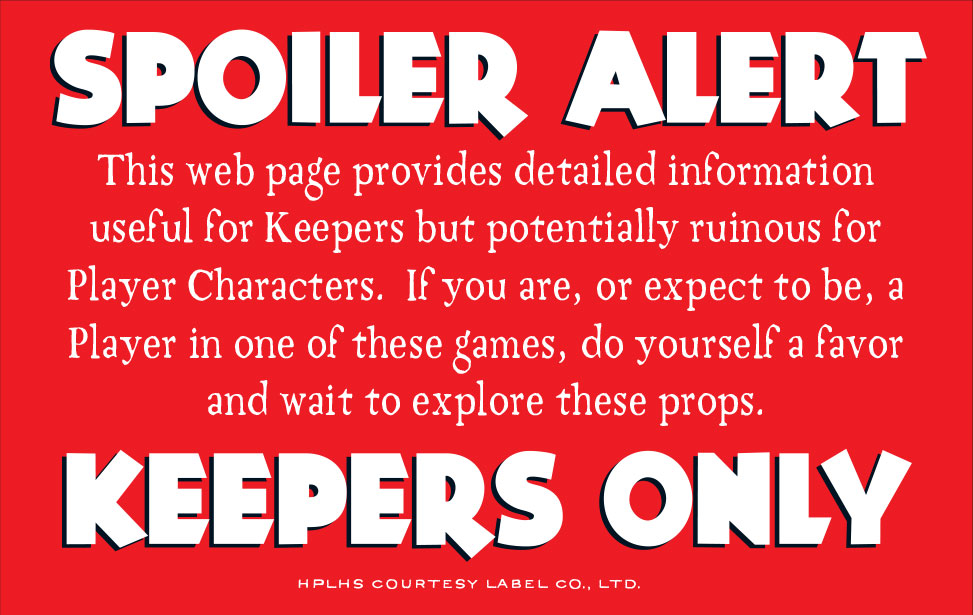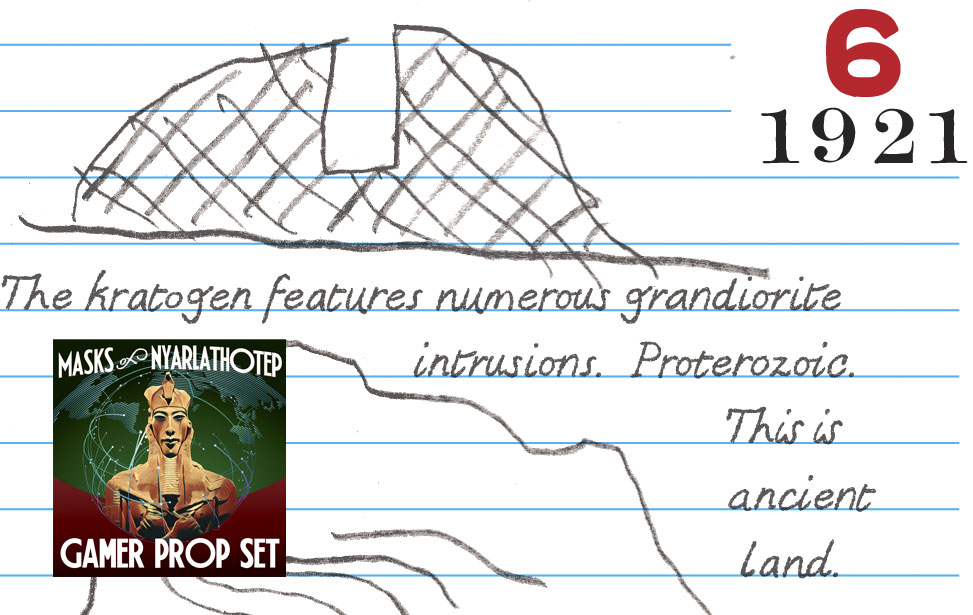Masks of Nyarlathotep: Gamer Prop Set
This page was set up specifically for owners of the Gamer Prop Set to tell you more about the props in your collection. Here you’ll find source material, inspirations, and other factoids that we hope will deepen your enjoyment of this very special HPLHS prop collection, and tips for Keepers to get the most use out of it.
KEEPERS PLEASE NOTE: Some of the prop documents in the collection are crumpled, torn, or otherwise imperfect. This is intentional. Many of the items are meant to look a little manhandled, or like they are torn out of books, newspapers, or bigger documents.
The props are listed below in the sequence in which they are packed in the box. First come "Other" props which would not fit or did not belong in the geographically-labeled folders. Then come the seven folders arranged in the same order used by Chaosium. The set includes extra props not specifically required by Chaosium's text, but which we thought would add to the fun. If you note that you are missing props in your set that are shown below, please do feel free to let us know and we'll do our best to replace them.
Get it now!The Props
 The text of Chaosium's supplement describes this item as a number of Chinese scrolls, so we thought it would be most fun to prepare our prop version as an actual scroll. Finding a domestic manufacturer of Chinese scrolls initially proved very difficult, so we turned to friends in China who put us in touch with a supplier there. We thank Ellen Fung for being our "comprador", and both her and David Mersault for assistance in getting the text translated into Mandarin.
The text of Chaosium's supplement describes this item as a number of Chinese scrolls, so we thought it would be most fun to prepare our prop version as an actual scroll. Finding a domestic manufacturer of Chinese scrolls initially proved very difficult, so we turned to friends in China who put us in touch with a supplier there. We thank Ellen Fung for being our "comprador", and both her and David Mersault for assistance in getting the text translated into Mandarin.
After the first two rounds of Chinese scrolls were produced, the situation in China changed for the worse and we were unable to keep sourcing the scrolls from overseas. We looked again for a domestic supplier, and although the vibe is rather different from the original version, the new scrolls are just as excellent in their own way.
We also provide the English version of the scroll text as a handout within the China folder, but Keepers are encouraged to first hand their players this Chinese scroll when interacting with the prop.
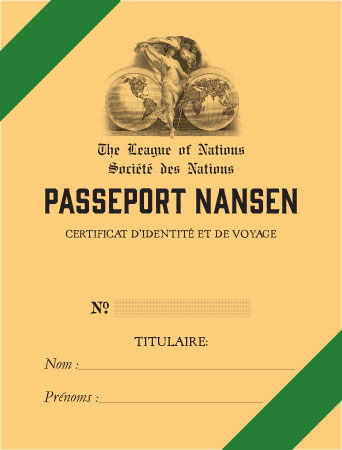 Because the players are going on a globe-spanning journey during this adventure, we thought it would be fun to give them passports to document their travels. Passports are usually issued by national governments to their citizens, but your investigator characters could be from anywhere, and we couldn't provide passports from every possible country. So we decided to offer stateless Nansen Passports that could theoretically be used by anyone. Named for famed polar explorer and statesman Fridtjof Nansen, these travel documents were issued by the League of Nations from 1922 to 1938, in response to the refugee crisis following WWI in which huge numbers of people were rendered stateless. You can learn more about them here. We took a little license with the design, and our version is a little fancier than most real ones were, and is partly based on other standard passport designs of the period. Keepers can encourage their players to include a photo of their characters, and enter their personal description in the appropriate spaces on page 3. The "notes" page in the back can be used to jot down important character skills, hit points, sanity level, etc., or any other data that's important to remember. The visa pages should be stamped by the Keeper as the character makes his/her way into and/or out of various countries. We've provided numerous stamps for that purpose, detailed below. Dates of entry and/or exit should be written in by hand, along with other pertinent official remarks. There is one visa page for each geographical area in the game, but if your characters go to unexpected or additional places, feel free to crowd the pages any way you want. The most fun passport is one that's full of stamps.
Because the players are going on a globe-spanning journey during this adventure, we thought it would be fun to give them passports to document their travels. Passports are usually issued by national governments to their citizens, but your investigator characters could be from anywhere, and we couldn't provide passports from every possible country. So we decided to offer stateless Nansen Passports that could theoretically be used by anyone. Named for famed polar explorer and statesman Fridtjof Nansen, these travel documents were issued by the League of Nations from 1922 to 1938, in response to the refugee crisis following WWI in which huge numbers of people were rendered stateless. You can learn more about them here. We took a little license with the design, and our version is a little fancier than most real ones were, and is partly based on other standard passport designs of the period. Keepers can encourage their players to include a photo of their characters, and enter their personal description in the appropriate spaces on page 3. The "notes" page in the back can be used to jot down important character skills, hit points, sanity level, etc., or any other data that's important to remember. The visa pages should be stamped by the Keeper as the character makes his/her way into and/or out of various countries. We've provided numerous stamps for that purpose, detailed below. Dates of entry and/or exit should be written in by hand, along with other pertinent official remarks. There is one visa page for each geographical area in the game, but if your characters go to unexpected or additional places, feel free to crowd the pages any way you want. The most fun passport is one that's full of stamps.
The Gamer Prop Set comes with six blank passports. If you need more than that, they are available separately from the HPLHS online store here.
If you have player characters who are from the USA or the United Kingdom, and you would rather give them passports issued by their national governments instead of a Nansen passport, the HPLHS offers both vintage US and UK passports as PDFs that you can print and assemble yourself in our general prop documents collection. You can check that out here. The collection also contains a lot of other general-purpose props that might come in handy while running the game.
 Passports in the 1920s were usually stamped by immigration officials with either rubber stamps or with revenue stamps that worked like traditional postage stamps. We couldn't provide a complete set of rubber stamps, so we are providing six sets of clear kiss-cut stickers that mimic the look of rubber stamps. Just peel them off the sheet and affix them to the visa pages in your players' passports as appropriate. There are stamps for each country in the game, along with corresponding "entry" and "exit" stamps, plus numerous assorted other "official" stamps for Keepers to deploy based on what actually happens to your players. It was common for immigration officials to add handwritten notations and/or signatures (often completely illegible) on top of official rubber stamps. A fine-point Sharpie will probably work best if you want to write on top of the clear passport stamp stickers.
Passports in the 1920s were usually stamped by immigration officials with either rubber stamps or with revenue stamps that worked like traditional postage stamps. We couldn't provide a complete set of rubber stamps, so we are providing six sets of clear kiss-cut stickers that mimic the look of rubber stamps. Just peel them off the sheet and affix them to the visa pages in your players' passports as appropriate. There are stamps for each country in the game, along with corresponding "entry" and "exit" stamps, plus numerous assorted other "official" stamps for Keepers to deploy based on what actually happens to your players. It was common for immigration officials to add handwritten notations and/or signatures (often completely illegible) on top of official rubber stamps. A fine-point Sharpie will probably work best if you want to write on top of the clear passport stamp stickers.
 Another fun way for your players to document their adventure is to track it on this large-format world map. Based on real vintage maps from 1923, this bonus map has been edited to include a couple of locations from the game which did not appear on the original map.
Another fun way for your players to document their adventure is to track it on this large-format world map. Based on real vintage maps from 1923, this bonus map has been edited to include a couple of locations from the game which did not appear on the original map.
The map measures 18 x 26 inches.
 The Chaosium supplement features several handouts that are transcripts of statements made by various NPCs. We thought it would be fun to render these as actual audio recordings, performed by actors and with a bit of sound context thrown in. With Chaosium's kind permission, we rewrote some of these for performance, and drafted some of the actors who are appearing in our Dark Adventure Radio Theatre adaptation of the game to play the same parts. There are a total of eight MP3 audio props, contained on the custom thumb drive inside the Ediphone cylinder. They should be playable on any device capable of playing MP3s.
The Chaosium supplement features several handouts that are transcripts of statements made by various NPCs. We thought it would be fun to render these as actual audio recordings, performed by actors and with a bit of sound context thrown in. With Chaosium's kind permission, we rewrote some of these for performance, and drafted some of the actors who are appearing in our Dark Adventure Radio Theatre adaptation of the game to play the same parts. There are a total of eight MP3 audio props, contained on the custom thumb drive inside the Ediphone cylinder. They should be playable on any device capable of playing MP3s.
We have also provided transcripts of the recordings as regular handouts inside the various folders. If we were running this game, we would play the MP3s for the players at the appropriate time, once only, and then withhold the handouts. If you can't play the MP3s or don't wish to, the transcripts are available to deploy in the usual manner. Please note that the transcripts do not necessarily match the text as presented in Chaosium's supplement: they match the HPLHS recordings.
Audio Engineering by Michael Dumas. Audio Editing and Sound Design by Sean Branney. Samir Shakur plays Jackson Elias. Dan Conroy plays Professor Cowles. Sean Branney plays Jeremy Grogan. Shawn Michal Savage plays Jack Brady. Time Winters plays Warren Besart. Kevin Stidham plays Reverend Stratton. Andrew Leman plays Sgt. Bumption. Phillip C. Curry plays Okomu, translating the words of Old Bundari.
 These lovely revenue stamps are to be affixed to one of the pages of the Nansen Passport, assuming the players make their way to Western Australia, to indicate that they have paid the necessary fees.
These lovely revenue stamps are to be affixed to one of the pages of the Nansen Passport, assuming the players make their way to Western Australia, to indicate that they have paid the necessary fees.
 These replicas of real British Consular Service stamps should be affixed to one of the pages of the Nansen Passport, to indicate that the player has paid the relevant fees for a visa to enter the United Kingdom. If the character is British, this stamp could be affixed to the page for Kenya, if desired, which was controlled by Great Britain at the time. It could also go on the inside front cover, next to the League of Nations seal.
These replicas of real British Consular Service stamps should be affixed to one of the pages of the Nansen Passport, to indicate that the player has paid the relevant fees for a visa to enter the United Kingdom. If the character is British, this stamp could be affixed to the page for Kenya, if desired, which was controlled by Great Britain at the time. It could also go on the inside front cover, next to the League of Nations seal.
 These stamps should be affixed to a page in the Nansen Passport, to indicate that the player has paid relevant processing fees. If the character is a U.S. citizen (and therefore not in need of a visa to enter the U.S.), the stamp could go on the inside front cover, next to the League of Nations seal.
These stamps should be affixed to a page in the Nansen Passport, to indicate that the player has paid relevant processing fees. If the character is a U.S. citizen (and therefore not in need of a visa to enter the U.S.), the stamp could go on the inside front cover, next to the League of Nations seal.
 A clipping from The New York Times. PLEASE NOTE: Your clipping may or may not be exactly the same size/shape as shown here. All the various newspaper clippings for this collection were written and designed and printed up in a giant full-size 12-page broadsheet newspaper. In order to get twice as many front pages, half of the newspaper is designed upside down. Our patient clipping shoggoths then meticulously disassemble these insanely complicated newspapers into the numerous different clippings, and there is always some variation in how specific individual clippings appear. All of the clippings include text and/or images on the reverse side, most pulled from actual newspapers from the time and place of the clipping itself. This particular clipping is surrounded and backed up by contemporary items from The New York Times.
A clipping from The New York Times. PLEASE NOTE: Your clipping may or may not be exactly the same size/shape as shown here. All the various newspaper clippings for this collection were written and designed and printed up in a giant full-size 12-page broadsheet newspaper. In order to get twice as many front pages, half of the newspaper is designed upside down. Our patient clipping shoggoths then meticulously disassemble these insanely complicated newspapers into the numerous different clippings, and there is always some variation in how specific individual clippings appear. All of the clippings include text and/or images on the reverse side, most pulled from actual newspapers from the time and place of the clipping itself. This particular clipping is surrounded and backed up by contemporary items from The New York Times.
 Our version of the telegram from Augustus Larkin is based on a real vintage telegram from Argentina. Our thanks to HPLHS Member Hugo Zaccheo of Buenos Aires for generously proofreading the Spanish and providing some insight into mysterious abbreviations.
Our version of the telegram from Augustus Larkin is based on a real vintage telegram from Argentina. Our thanks to HPLHS Member Hugo Zaccheo of Buenos Aires for generously proofreading the Spanish and providing some insight into mysterious abbreviations.
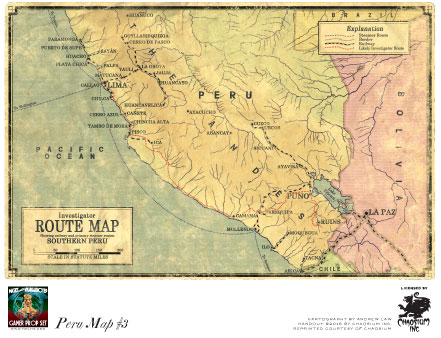 This is a reprint of Chaosium's handout, provided by permission. Cartography by Andrew Law.
This is a reprint of Chaosium's handout, provided by permission. Cartography by Andrew Law.
 Since the English version is available in Chaosium's supplement, we thought it would be fun to present this written in Spanish, and torn from a spiral notebook. Our thanks again to HPLHS Member Hugo Zaccheo who translated the notes into Spanish.
Since the English version is available in Chaosium's supplement, we thought it would be fun to present this written in Spanish, and torn from a spiral notebook. Our thanks again to HPLHS Member Hugo Zaccheo who translated the notes into Spanish.
 This is a reprint of Chaosium's handout, provided by permission. Cartography by Andrew Law. The Keeper's Version printed in the supplement contains additional information not shown on the player handout.
This is a reprint of Chaosium's handout, provided by permission. Cartography by Andrew Law. The Keeper's Version printed in the supplement contains additional information not shown on the player handout.
 This lovely map is based on a map of Peru from 1913. This is the first of several large-format prop maps in the collection. We placed it at the end of the Peru folder because it does not match the Keeper's map shown in the Chaosium supplement, but is a prop vintage map that the PCs might acquire at any time. Keepers can feel free to give their players this map if/when they first decide to go to Peru, or at least as soon as they actually get there. It does not contain any of the Keeper information shown on the map in the Chaosium supplement.
This lovely map is based on a map of Peru from 1913. This is the first of several large-format prop maps in the collection. We placed it at the end of the Peru folder because it does not match the Keeper's map shown in the Chaosium supplement, but is a prop vintage map that the PCs might acquire at any time. Keepers can feel free to give their players this map if/when they first decide to go to Peru, or at least as soon as they actually get there. It does not contain any of the Keeper information shown on the map in the Chaosium supplement.
The map measures 20.5 x 14 inches
 Our version of the telegram from Jackson Elias is a replica of a real telegram from the Postal Telegraph Company, which was a major US telegram company that competed with Western Union in the 1920s. The data at the top of the telegram is the "check", which shows that the message was sent from aboard a steamship called the Antenor.
Our version of the telegram from Jackson Elias is a replica of a real telegram from the Postal Telegraph Company, which was a major US telegram company that competed with Western Union in the 1920s. The data at the top of the telegram is the "check", which shows that the message was sent from aboard a steamship called the Antenor.
 This is a reprint of Chaosium's handout, provided by permission. This is the version to use if your PCs have played the Peru section of the game.
This is a reprint of Chaosium's handout, provided by permission. This is the version to use if your PCs have played the Peru section of the game.
 This is a reprint of Chaosium's handout, provided by permission. This is the version to use if your PCs have not played the Peru section of the game.
This is a reprint of Chaosium's handout, provided by permission. This is the version to use if your PCs have not played the Peru section of the game.
 This is the first of several clippings from The New York Pillar/Riposte, a delightful but fictional newspaper. Our design is inspired by a number of real New York City tabloids of the day, including the Amsterdam News. The image of Carlyle is that of a very famous young heartthrob of the day (he plays Carlyle in photos in other clippings as well), and other items in the society column were pulled from real papers of the day. The back side features news of the death of Sir William Crookes, who really did die that day in 1919, and a contemporary ad for Saks & Co.
This is the first of several clippings from The New York Pillar/Riposte, a delightful but fictional newspaper. Our design is inspired by a number of real New York City tabloids of the day, including the Amsterdam News. The image of Carlyle is that of a very famous young heartthrob of the day (he plays Carlyle in photos in other clippings as well), and other items in the society column were pulled from real papers of the day. The back side features news of the death of Sir William Crookes, who really did die that day in 1919, and a contemporary ad for Saks & Co.
PLEASE NOTE: Your clipping may or may not be exactly the same size/shape as shown here. All the various newspaper clippings for this collection were designed and printed up in a giant full-size 12-page broadsheet newspaper. In order to get twice as many front pages, half of the newspaper is designed upside down. Our patient clipping shoggoths then meticulously disassemble these insanely complicated newspapers into the numerous different clippings, and there is always some variation in how specific individual clippings appear. All of the clippings include text and/or images on the reverse side, most pulled from actual newspapers from the time and place of the clipping itself.
 Rather than just a small clipping, we thought it would be fun to include an entire half page from the Pillar/Riposte so your players could get the feel of reading the whole paper and seeing other news of the day. All of the other news items are real ones taken from New York newspapers from that time.
Rather than just a small clipping, we thought it would be fun to include an entire half page from the Pillar/Riposte so your players could get the feel of reading the whole paper and seeing other news of the day. All of the other news items are real ones taken from New York newspapers from that time.
 By this time, we figured the story of the Carlyle Expedition was no longer front-page news, so this clipping comes from somewhere deeper inside the paper.
By this time, we figured the story of the Carlyle Expedition was no longer front-page news, so this clipping comes from somewhere deeper inside the paper.
 Once they've left New York, additional news of the expedition comes to the Pillar/Riposte by way of the Reuters agency, an international news-gathering agency that supplied newspapers worldwide. The Reuters agency was established in 1851 by Paul Julius Reuter, who in 1850 had developed a prototype news service using homing pigeons and electric telegraphy to transmit messages between Brussels and Aachen. Reuters was the first to report Abraham Lincoln's assassination in Europe in 1865. In 1883, Reuters began transmitting messages electrically to London newspapers. In 1923, Reuters began using radio to transmit news internationally, a pioneering act. The amusing story on the reverse of this clipping is a real item from a contemporary New York tabloid.
Once they've left New York, additional news of the expedition comes to the Pillar/Riposte by way of the Reuters agency, an international news-gathering agency that supplied newspapers worldwide. The Reuters agency was established in 1851 by Paul Julius Reuter, who in 1850 had developed a prototype news service using homing pigeons and electric telegraphy to transmit messages between Brussels and Aachen. Reuters was the first to report Abraham Lincoln's assassination in Europe in 1865. In 1883, Reuters began transmitting messages electrically to London newspapers. In 1923, Reuters began using radio to transmit news internationally, a pioneering act. The amusing story on the reverse of this clipping is a real item from a contemporary New York tabloid.
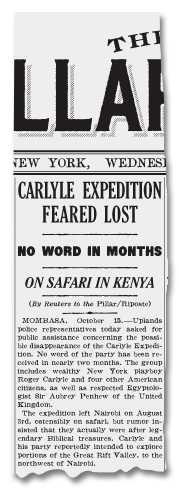 Now that the story is getting juicy again, news of the Carlyle Expedition returns to the front page of the Pillar/Riposte.
Now that the story is getting juicy again, news of the Carlyle Expedition returns to the front page of the Pillar/Riposte.
 The item above the Carlyle clipping is a real verbatim news item from the time, and it is interesting to note that all of the women in the story are referred to exclusively by their husband's names. Erica Carlyle is the only woman in the clipping with her own identity. The back of the clipping features an ad that might be familiar to listeners of Dark Adventure Radio Theatre.
The item above the Carlyle clipping is a real verbatim news item from the time, and it is interesting to note that all of the women in the story are referred to exclusively by their husband's names. Erica Carlyle is the only woman in the clipping with her own identity. The back of the clipping features an ad that might be familiar to listeners of Dark Adventure Radio Theatre.
 This page-one item is surrounded by crosses, which was done in some newspapers to highlight stories about the death of prominent figures, such as political assassinations. The mad-looking gentleman pictured on the back of the clipping is John Armstrong Chaloner, a fascinating figure of the 1920s who is mentioned in one of the items on the full half-page clipping. You can learn more about him here.
This page-one item is surrounded by crosses, which was done in some newspapers to highlight stories about the death of prominent figures, such as political assassinations. The mad-looking gentleman pictured on the back of the clipping is John Armstrong Chaloner, a fascinating figure of the 1920s who is mentioned in one of the items on the full half-page clipping. You can learn more about him here.
 This item is very slightly changed from Chaosium's original text, because we are including a bonus clipping from a different newspaper that covers some of the same material.
This item is very slightly changed from Chaosium's original text, because we are including a bonus clipping from a different newspaper that covers some of the same material.
 This is the first of the items recovered from Jackson Elias' hotel room in New York City, and is one of the core props of the game. This handwritten letter came into Elias' possession via Jack Brady, and it's a little bit crumpled because it's travelled around the world in Brady's pocket. Our thanks to HPLHS Member Jay Stigdon for providing the penmanship of Warren Besart with a real fountain pen.
This is the first of the items recovered from Jackson Elias' hotel room in New York City, and is one of the core props of the game. This handwritten letter came into Elias' possession via Jack Brady, and it's a little bit crumpled because it's travelled around the world in Brady's pocket. Our thanks to HPLHS Member Jay Stigdon for providing the penmanship of Warren Besart with a real fountain pen.
 This is another item found in Elias' hotel room. The linen finish is the choice of insane villains everywhere.
This is another item found in Elias' hotel room. The linen finish is the choice of insane villains everywhere.
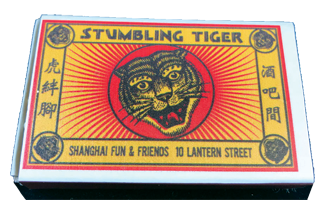 We decided to do a box of matches rather than a book for a few different reasons. It somehow feels more 1920s to us, plus if you want you can empty out the matches and hide some other kind of clue inside the box. Also, we did a matchbook for the Innsmouth House hotel for our Dark Adventure Radio Theatre episode of "The Shadow Over Innsmouth", and we wanted to try something different.
We decided to do a box of matches rather than a book for a few different reasons. It somehow feels more 1920s to us, plus if you want you can empty out the matches and hide some other kind of clue inside the box. Also, we did a matchbook for the Innsmouth House hotel for our Dark Adventure Radio Theatre episode of "The Shadow Over Innsmouth", and we wanted to try something different.
 Our photo is perhaps not as blurry as described in Chaosium's supplement, but we just didn't have the heart to blur this lovely 1929 photo of the Bund in Shanghai. Most of the boats in the river are from the original photo, but the Dark Mistress itself was composited in, as were the junks partially obscuring it from view. Elias presumably got this photo from Jack Brady.
Our photo is perhaps not as blurry as described in Chaosium's supplement, but we just didn't have the heart to blur this lovely 1929 photo of the Bund in Shanghai. Most of the boats in the river are from the original photo, but the Dark Mistress itself was composited in, as were the junks partially obscuring it from view. Elias presumably got this photo from Jack Brady.
 This is another of the items recovered from Elias' hotel room. Elias' handwriting on the back is based on the handwriting of H.P. Lovecraft himself.
This is another of the items recovered from Elias' hotel room. Elias' handwriting on the back is based on the handwriting of H.P. Lovecraft himself.
 This is a fictionalized version of Harvard letterhead. The postpaid envelope, however, was pretty common for institutions at the time.
This is a fictionalized version of Harvard letterhead. The postpaid envelope, however, was pretty common for institutions at the time.
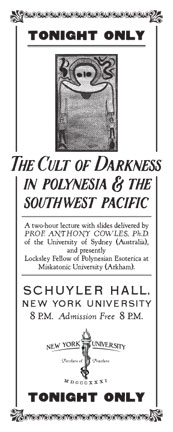 This is the last of the clues personally collected by Jackson Elias and recovered from his room at the Hotel Chelsea.
This is the last of the clues personally collected by Jackson Elias and recovered from his room at the Hotel Chelsea.
 In order to turn Jackson Elias' forehead into a prop, we decided the best way was to stage an NYPD crime scene photo. Keepers can decide whether their players see the actual wounds or this picture, sometime after the fact. Our thanks to Special Makeup Effects wizard Dave Snyder for doing the makeup, and to actor Samir Shakur for playing Jackson Elias.
In order to turn Jackson Elias' forehead into a prop, we decided the best way was to stage an NYPD crime scene photo. Keepers can decide whether their players see the actual wounds or this picture, sometime after the fact. Our thanks to Special Makeup Effects wizard Dave Snyder for doing the makeup, and to actor Samir Shakur for playing Jackson Elias.
For a video of the makeup being applied, CLICK HERE
For another video of the makeup being applied, CLICK HERE
 This is a clipping from The New York Times, somewhat expanded from the text given in Chaosium's supplement. It was rather unusual for reporters to get a byline for a news item in the Times in 1925. The story on the back of the clipping is a real news item from the NYT of that day.
This is a clipping from The New York Times, somewhat expanded from the text given in Chaosium's supplement. It was rather unusual for reporters to get a byline for a news item in the Times in 1925. The story on the back of the clipping is a real news item from the NYT of that day.
 Chaosium's supplement describes this as a handwritten note, but we thought it would be fun to present it as an Ediphone recording so your players can hear Jackson's voice. Wax cylinder phonographs were popular dictation instruments at the time, and Ediphone was, of course, Thomas Edison's brand. We imagine that Carlton Ramsey has an Ediphone in his office, and Jackson dictated this final message on his lawyer's machine. This handout contains the transcript of the audio prop found on the thumb drive inside the Ediphone cylinder. It matches the recording, not the text in Chaosium's supplement. Because this audio prop is itself meant to be a recording, Keepers can let their players listen to it multiple times if they desire. Samir Shakur plays Jackson Elias.
Chaosium's supplement describes this as a handwritten note, but we thought it would be fun to present it as an Ediphone recording so your players can hear Jackson's voice. Wax cylinder phonographs were popular dictation instruments at the time, and Ediphone was, of course, Thomas Edison's brand. We imagine that Carlton Ramsey has an Ediphone in his office, and Jackson dictated this final message on his lawyer's machine. This handout contains the transcript of the audio prop found on the thumb drive inside the Ediphone cylinder. It matches the recording, not the text in Chaosium's supplement. Because this audio prop is itself meant to be a recording, Keepers can let their players listen to it multiple times if they desire. Samir Shakur plays Jackson Elias.
 We thought it would be fun if Jackson's final letter to his publisher was written on letterhead from one of the last hotels he stayed in: the Hampton House in Nairobi. Elias' handwriting is based on that of H.P. Lovecraft.
We thought it would be fun if Jackson's final letter to his publisher was written on letterhead from one of the last hotels he stayed in: the Hampton House in Nairobi. Elias' handwriting is based on that of H.P. Lovecraft.
 We wanted to expand a bit on the text provided in Chaosium's supplement, and provide a look into the workings of Prospero House, Elias' publisher. We've presented Elias' Nairobi notes in the form of an official in-house summary on Prospero House letterhead.
We wanted to expand a bit on the text provided in Chaosium's supplement, and provide a look into the workings of Prospero House, Elias' publisher. We've presented Elias' Nairobi notes in the form of an official in-house summary on Prospero House letterhead.
 We wanted to provide some bonus content for these final notes from Jackson Elias, so Sean Branney augmented them with extra material, including the little chess sketch shown on the reverse. Having established that Elias uses letterhead from the various hotels where he stays, we invented one for London. The handwriting is based on that of H.P. Lovecraft.
We wanted to provide some bonus content for these final notes from Jackson Elias, so Sean Branney augmented them with extra material, including the little chess sketch shown on the reverse. Having established that Elias uses letterhead from the various hotels where he stays, we invented one for London. The handwriting is based on that of H.P. Lovecraft.
 Chaosium's supplement describes this book as a diary from 1810, so we put it on some rather aged paper and present one crucial page torn from the rest of the book.
Chaosium's supplement describes this book as a diary from 1810, so we put it on some rather aged paper and present one crucial page torn from the rest of the book.
 This handout is a transcript of the audio prop to be found on the thumb drive inside the Ediphone cylinder. In Chaosium's supplement, this item is presented as a written summary of Cowles' lecture. We thought it would be fun to reimagine it as an Ediphone recording of the lecture, although one that was only partially successful. If your PCs actually meet with Anthony Cowles, he might present them with this recording of the lecture, which they can play repeatedly if they desire. Dan Conroy plays Anthony Cowles, and Kevin Stidham also appears as Daniel, the hapless recording engineer.
This handout is a transcript of the audio prop to be found on the thumb drive inside the Ediphone cylinder. In Chaosium's supplement, this item is presented as a written summary of Cowles' lecture. We thought it would be fun to reimagine it as an Ediphone recording of the lecture, although one that was only partially successful. If your PCs actually meet with Anthony Cowles, he might present them with this recording of the lecture, which they can play repeatedly if they desire. Dan Conroy plays Anthony Cowles, and Kevin Stidham also appears as Daniel, the hapless recording engineer.
 Cowles' lecture was accompanied by slides showing the mysterious ruins discovered by Arthur MacWhirr. We thought it would be fun to provide at least one of those images. This photo is a print made from one of the slides damaged by the heat of the Australian desert, and shows MacWhirr standing in front of some very curious geological/architectural formations in Western Australia.
Cowles' lecture was accompanied by slides showing the mysterious ruins discovered by Arthur MacWhirr. We thought it would be fun to provide at least one of those images. This photo is a print made from one of the slides damaged by the heat of the Australian desert, and shows MacWhirr standing in front of some very curious geological/architectural formations in Western Australia.
 Chaosium's supplement provides one page summarizing Dr. Huston's medical notes about Roger Carlyle. We thought it would be fun to expand on them, so Sean Branney went insane and wrote 21 pages of detailed notes on Carlyle's therapy that reveals as much about Huston himself as it reveals about Carlyle. We then put that entire file of notes into a folder that was sealed as evidence by the New York Medical Affairs Board. It is up to the Keeper to decide if he/she wants to break that evidence seal or let the PCs do it. We think it would be the most fun for you all to discover it together.
Chaosium's supplement provides one page summarizing Dr. Huston's medical notes about Roger Carlyle. We thought it would be fun to expand on them, so Sean Branney went insane and wrote 21 pages of detailed notes on Carlyle's therapy that reveals as much about Huston himself as it reveals about Carlyle. We then put that entire file of notes into a folder that was sealed as evidence by the New York Medical Affairs Board. It is up to the Keeper to decide if he/she wants to break that evidence seal or let the PCs do it. We think it would be the most fun for you all to discover it together.
 This is a reprint of Chaosium's handout, provided by permission. Cartography by Andrew Law.
This is a reprint of Chaosium's handout, provided by permission. Cartography by Andrew Law.
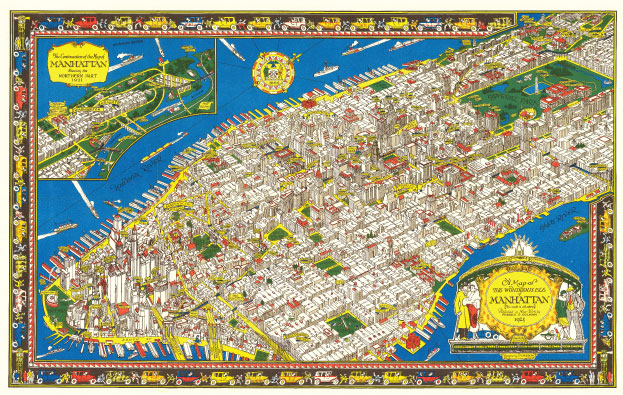 This large-format bonus prop is an edited replica of an amazing map of New York City published by the Washington Square Book Shop in 1926. It is a real vintage map that does not contain any Keeper information, so you can hand it to your players at any time once they are in New York City.
This large-format bonus prop is an edited replica of an amazing map of New York City published by the Washington Square Book Shop in 1926. It is a real vintage map that does not contain any Keeper information, so you can hand it to your players at any time once they are in New York City.
This map measures 26 x 16.5 inches.
 Jackson Elias had several books published by Prospero House before his death, and we thought it would be fun to provide the dust jacket for at least one of them. Of course we have no idea what books you might have in your library, but this dust jacket is designed to fit over the Arkham House hardback edition of "At the Mountains of Madness". It should fit over any number of other more or less standard sized books as well.
Jackson Elias had several books published by Prospero House before his death, and we thought it would be fun to provide the dust jacket for at least one of them. Of course we have no idea what books you might have in your library, but this dust jacket is designed to fit over the Arkham House hardback edition of "At the Mountains of Madness". It should fit over any number of other more or less standard sized books as well.
 Because the beautiful vintage map of New York City we found conspicuously omits Harlem, we wanted to make sure it was covered. This is a reprint of Chaosium's excellent map of the neighborhood, cartography by Andrew Law.
Because the beautiful vintage map of New York City we found conspicuously omits Harlem, we wanted to make sure it was covered. This is a reprint of Chaosium's excellent map of the neighborhood, cartography by Andrew Law.
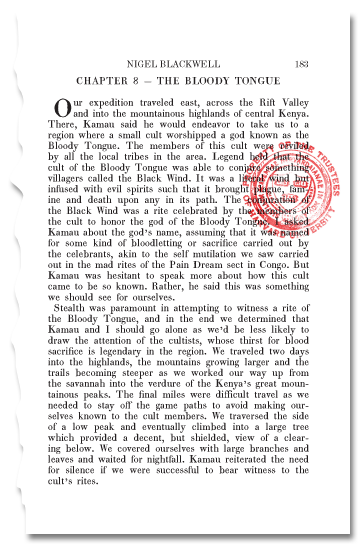 Chaosium's supplement mentions and quotes from this important book, and we thought it would be fun to provide a crucial page torn from it. The PCs might find the book in M'Dari's alcove in the basement of the Ju-Ju House.
Chaosium's supplement mentions and quotes from this important book, and we thought it would be fun to provide a crucial page torn from it. The PCs might find the book in M'Dari's alcove in the basement of the Ju-Ju House.
 This is the first of several clippings from The Scoop, a delightful but fictional British tabloid. Our design is inspired by a number of real London tabloids of the day, including the Pall Mall Gazette. Given the sensational nature of the paper's coverage, we have taken some typographical liberties with the headlines. The back of this clipping features a real vintage photo of a 1920s girls' rifle team.
This is the first of several clippings from The Scoop, a delightful but fictional British tabloid. Our design is inspired by a number of real London tabloids of the day, including the Pall Mall Gazette. Given the sensational nature of the paper's coverage, we have taken some typographical liberties with the headlines. The back of this clipping features a real vintage photo of a 1920s girls' rifle team.
PLEASE NOTE: Your clipping may or may not be exactly the same size/shape as shown here. All the various newspaper clippings for this collection were designed and printed up in a giant full-size 12-page broadsheet newspaper. In order to get twice as many front pages, half of the newspaper is designed upside down. Our patient clipping shoggoths then meticulously disassemble these insanely complicated newspapers into the numerous different clippings, and there is always some variation in how specific individual clippings appear.
 Chaosium's supplement does not provide a specific date for either this or the other clippings from The Scoop, but says they should be from some time in the recent past. If the dates we've chosen to include cause any kind of timeline conflict for Keepers, they can be blacked out and/or ignored.
Chaosium's supplement does not provide a specific date for either this or the other clippings from The Scoop, but says they should be from some time in the recent past. If the dates we've chosen to include cause any kind of timeline conflict for Keepers, they can be blacked out and/or ignored.
 For each of the various newspapers represented in the collection, we wanted at least one clipping to be a full half page, so your players could get a sense of the whole paper and see some other news of the day. The other sensational items in this prop are all lifted from British tabloids of 1924. Our thanks to HPLHS Member David G. Cercone II for spending hours in the microfilm department of the Library of Congress in Washington DC, getting samples from The Daily Mail, The Star, and The Sphere.
For each of the various newspapers represented in the collection, we wanted at least one clipping to be a full half page, so your players could get a sense of the whole paper and see some other news of the day. The other sensational items in this prop are all lifted from British tabloids of 1924. Our thanks to HPLHS Member David G. Cercone II for spending hours in the microfilm department of the Library of Congress in Washington DC, getting samples from The Daily Mail, The Star, and The Sphere.
 This is a reprint of Chaosium's handout, provided by permission. Cartography by Andrew Law.
This is a reprint of Chaosium's handout, provided by permission. Cartography by Andrew Law.
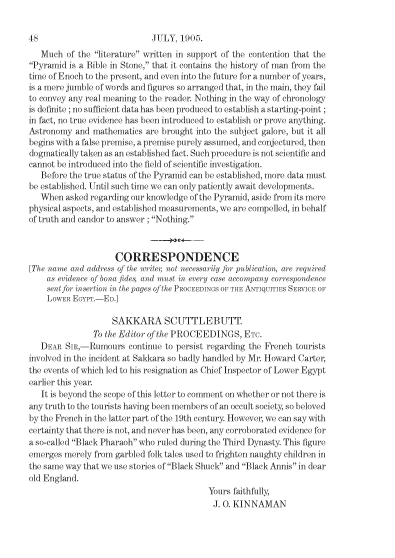 To provide a full page of context for this item, we lifted text from a vintage booklet about Egyptian archaeology by J. O. Kinnaman. This page is torn from a full copy of an academic journal.
To provide a full page of context for this item, we lifted text from a vintage booklet about Egyptian archaeology by J. O. Kinnaman. This page is torn from a full copy of an academic journal.
 Our version of the Clive Telegram is a replica of a real vintage British telegram.
Our version of the Clive Telegram is a replica of a real vintage British telegram.
 The £108 paid for the "walk-in safe" noted on this receipt would be about $8600 in today's money, according to Eric W. Nye, Pounds Sterling to Dollars: Historical Conversion of Currency.
The £108 paid for the "walk-in safe" noted on this receipt would be about $8600 in today's money, according to Eric W. Nye, Pounds Sterling to Dollars: Historical Conversion of Currency.
 The Empire Spices logo names a number of exotic locales from which various spices were imported.
The Empire Spices logo names a number of exotic locales from which various spices were imported.
 The brand of cigarettes advertised on the back of this clipping was a real one, manufactured in Egypt by a Greek tobacco entrepreneur named S. Anargyros. After WWI, Egyptian and Turkish tobaccos lost ground to American tobacco grown in Virginia, and Egyptian cigarettes fell behind.
The brand of cigarettes advertised on the back of this clipping was a real one, manufactured in Egypt by a Greek tobacco entrepreneur named S. Anargyros. After WWI, Egyptian and Turkish tobaccos lost ground to American tobacco grown in Virginia, and Egyptian cigarettes fell behind.
 This is a reprint of Chaosium's handout, provided by permission. Cartography by Andrew Law.
This is a reprint of Chaosium's handout, provided by permission. Cartography by Andrew Law.
 This is a reprint of Chaosium's handout, provided by permission. Cartography by Andrew Law.
This is a reprint of Chaosium's handout, provided by permission. Cartography by Andrew Law.
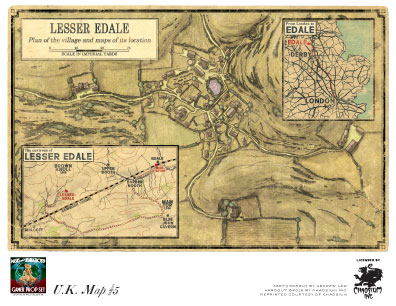 This is a reprint of Chaosium's handout, provided by permission. Cartography by Andrew Law.
This is a reprint of Chaosium's handout, provided by permission. Cartography by Andrew Law.
 This handout is a transcript of the audio prop to be found on the thumb drive inside the Ediphone cylinder. Because this is meant to be direct testimony from a living person, we recommend that Keepers allow their players to hear the recording one time only. They may then choose to withhold this transcript, thus compelling their players to remember, or not, what the Reverend said. Merciful Keepers may choose to let their players have this transcript. Kevin Stidham plays Reverend Stratton.
This handout is a transcript of the audio prop to be found on the thumb drive inside the Ediphone cylinder. Because this is meant to be direct testimony from a living person, we recommend that Keepers allow their players to hear the recording one time only. They may then choose to withhold this transcript, thus compelling their players to remember, or not, what the Reverend said. Merciful Keepers may choose to let their players have this transcript. Kevin Stidham plays Reverend Stratton.
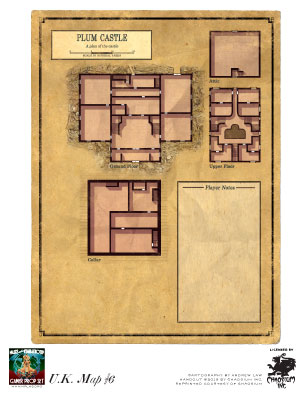 This is a reprint of Chaosium's handout, provided by permission. Cartography by Andrew Law.
This is a reprint of Chaosium's handout, provided by permission. Cartography by Andrew Law.
 This is a reprint of Chaosium's handout, provided by permission. Cartography by Andrew Law.
This is a reprint of Chaosium's handout, provided by permission. Cartography by Andrew Law.
 This is a reprint of Chaosium's handout, provided by permission. Cartography by Andrew Law.
This is a reprint of Chaosium's handout, provided by permission. Cartography by Andrew Law.
 This is a reprint of Chaosium's handout, provided by permission. Cartography by Andrew Law.
This is a reprint of Chaosium's handout, provided by permission. Cartography by Andrew Law.
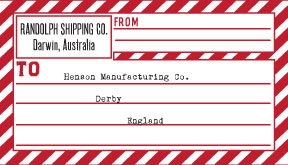 This item is an actual label that Keepers can affix to a shipping box if they so desire.
This item is an actual label that Keepers can affix to a shipping box if they so desire.
 This is a reprint of Chaosium's handout, provided by permission. Cartography by Andrew Law.
This is a reprint of Chaosium's handout, provided by permission. Cartography by Andrew Law.
 Al-Shakti's letterhead features metallic gold ink on Havilland Blue linen finish paper, marking him as a true supervillain.
Al-Shakti's letterhead features metallic gold ink on Havilland Blue linen finish paper, marking him as a true supervillain.
 These pages from Gavigan's ledger feature a few extra entries in addition to the ones in Chaosium's supplement. Gavigan's handwriting is based on that of American poet Sidney Lanier.
These pages from Gavigan's ledger feature a few extra entries in addition to the ones in Chaosium's supplement. Gavigan's handwriting is based on that of American poet Sidney Lanier.
 We find ourselves wondering why Gavigan stopped this letter mid-sentence, and what he would have gone on to write.
We find ourselves wondering why Gavigan stopped this letter mid-sentence, and what he would have gone on to write.
 This large-format map is a replica of a real one from 1890. Although it is a little bit older, we chose it because it shows the city from Soho to the Limehouse Reach. Since it is a real map without any Keeper information on it, Keepers can give it to their players at any time once they have decided to visit London. The Keeper's map of London contained in Chaosium's supplement shows the specific locations of various real and fictional sites.
This large-format map is a replica of a real one from 1890. Although it is a little bit older, we chose it because it shows the city from Soho to the Limehouse Reach. Since it is a real map without any Keeper information on it, Keepers can give it to their players at any time once they have decided to visit London. The Keeper's map of London contained in Chaosium's supplement shows the specific locations of various real and fictional sites.
This map measures 24 x 18 inches.
 We thought it would be fun to include an extra receipt as a bonus clue. This one might be found with the Whitfield receipt on Edward Gavigan's desk, or it might be found amongst papers at Empire Spices. It bears Zahra Shafik's signature, but perhaps she submits such receipts to Gavigan for reimbursement.
We thought it would be fun to include an extra receipt as a bonus clue. This one might be found with the Whitfield receipt on Edward Gavigan's desk, or it might be found amongst papers at Empire Spices. It bears Zahra Shafik's signature, but perhaps she submits such receipts to Gavigan for reimbursement.
 We thought it would be fun to provide a glimpse of some of the hybrid Yithian technology being developed at Henson Manufacturing in Derby, and at the same time an early sample of Penhew's handwriting that could be compared and correlated to other documents by him. The Investigators might find this revealing document in the workshop at Henson Manufacturing. It is based on real German sketches of a theoretical uranium bomb.
We thought it would be fun to provide a glimpse of some of the hybrid Yithian technology being developed at Henson Manufacturing in Derby, and at the same time an early sample of Penhew's handwriting that could be compared and correlated to other documents by him. The Investigators might find this revealing document in the workshop at Henson Manufacturing. It is based on real German sketches of a theoretical uranium bomb.
The schematic measures 19 x 13 inches.
 This handout is a transcript of the audio prop to be found on the thumb drive inside the Ediphone cylinder. Because this is meant to be direct testimony from a living person, we recommend that Keepers allow their players to hear the recording one time only. They may then choose to withhold this transcript, thus compelling their players to remember, or not, what Besart said. Merciful Keepers may choose to let their players have this transcript. Time Winters plays Warren Besart.
This handout is a transcript of the audio prop to be found on the thumb drive inside the Ediphone cylinder. Because this is meant to be direct testimony from a living person, we recommend that Keepers allow their players to hear the recording one time only. They may then choose to withhold this transcript, thus compelling their players to remember, or not, what Besart said. Merciful Keepers may choose to let their players have this transcript. Time Winters plays Warren Besart.
 Technically, this prop should be the actual fragment of the Eye of Light and Darkness, and in the Super Deluxe Edition of the Dark Adventure Radio Theatre adaptation it will be. But for this prop set, we decided to go with a photograph. Perhaps it is a photo taken by the Investigators themselves, or perhaps it is one given to them by Nuri's son, Ubaid.
Technically, this prop should be the actual fragment of the Eye of Light and Darkness, and in the Super Deluxe Edition of the Dark Adventure Radio Theatre adaptation it will be. But for this prop set, we decided to go with a photograph. Perhaps it is a photo taken by the Investigators themselves, or perhaps it is one given to them by Nuri's son, Ubaid.
 This is a clipping from The Cairo Bulletin, a fictional newspaper. Our design is inspired by The Egyptian Gazette, a comparable paper published in English in Alexandria at the time. The classified ads on the reverse are real ones lifted from the Gazette. Our thanks again to HPLHS Member David G. Cercone II for doing research at the Library of Congress.
This is a clipping from The Cairo Bulletin, a fictional newspaper. Our design is inspired by The Egyptian Gazette, a comparable paper published in English in Alexandria at the time. The classified ads on the reverse are real ones lifted from the Gazette. Our thanks again to HPLHS Member David G. Cercone II for doing research at the Library of Congress.
PLEASE NOTE: Your clipping may or may not be exactly the same size/shape as shown here. All the various newspaper clippings for this collection were designed and printed up in a giant full-size 12-page broadsheet newspaper. In order to get twice as many front pages, half of the newspaper is designed upside down. Our hard-working clipping shoggoths then meticulously disassemble these insanely complicated newspapers into the numerous different items, and there is always some variation in how specific individual clippings appear.
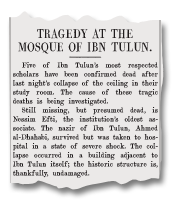 The reverse of this clipping features just a glimpse of Shepheard's Hotel, which was one of the finest hotels in Cairo, offering European luxury to a wealthy clientele. It burned down in 1952.
The reverse of this clipping features just a glimpse of Shepheard's Hotel, which was one of the finest hotels in Cairo, offering European luxury to a wealthy clientele. It burned down in 1952.
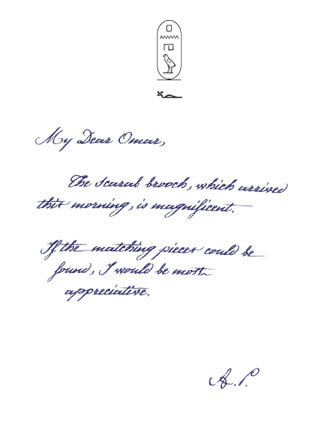 This little note is written on Aubrey Penhew's personal notepaper. Investigators who can read Egyptian hieroglyphics might recognize the name "Penhew" in the cartouche at the top, or at least recognize it from the Penhew Foundation business card. They might also note the little viper below the cartouche, Sir Aubrey's personal little symbol. The handwriting and initials "A.P." can be compared to the writing on the Yithian bomb schematic, if the Investigators found it at Henson Manufacturing.
This little note is written on Aubrey Penhew's personal notepaper. Investigators who can read Egyptian hieroglyphics might recognize the name "Penhew" in the cartouche at the top, or at least recognize it from the Penhew Foundation business card. They might also note the little viper below the cartouche, Sir Aubrey's personal little symbol. The handwriting and initials "A.P." can be compared to the writing on the Yithian bomb schematic, if the Investigators found it at Henson Manufacturing.
 This is a reprint of Chaosium's handout, provided by permission. Cartography by Andrew Law.
This is a reprint of Chaosium's handout, provided by permission. Cartography by Andrew Law.
 This large-format map is a replica of a real one from 1920. Since it is a real map without any Keeper information on it, Keepers can give it to their players at any time once they have decided to visit Cairo. The Keeper's map of Cairo contained in Chaosium's supplement shows the specific locations of various real and fictional sites.
This large-format map is a replica of a real one from 1920. Since it is a real map without any Keeper information on it, Keepers can give it to their players at any time once they have decided to visit Cairo. The Keeper's map of Cairo contained in Chaosium's supplement shows the specific locations of various real and fictional sites.
This map measures 26 x 18 inches.
 This is the half-page clipping of The Cairo Bulletin, with real ads and news items taken from contemporary issues of The Egyptian Gazette. It was not uncommon for the front pages of British colonial newspapers to be entirely devoted to ads, and comparatively rare to run such a large photograph, but we thought it would be fun to include a photo of the Carlyle Expedition group, and this is a doctored photo of a real group of 1920s Egyptologists.
This is the half-page clipping of The Cairo Bulletin, with real ads and news items taken from contemporary issues of The Egyptian Gazette. It was not uncommon for the front pages of British colonial newspapers to be entirely devoted to ads, and comparatively rare to run such a large photograph, but we thought it would be fun to include a photo of the Carlyle Expedition group, and this is a doctored photo of a real group of 1920s Egyptologists.
 Another item from The Cairo Bulletin, chronicling the comings and goings of Carlyle's group.
Another item from The Cairo Bulletin, chronicling the comings and goings of Carlyle's group.
 A gossip column from The Cairo Bulletin that diligent investigators might find in the morgue. The story on the back about the dog is a real one.
A gossip column from The Cairo Bulletin that diligent investigators might find in the morgue. The story on the back about the dog is a real one.
 We could not resist including just one more clipping from The Cairo Bulletin when we saw this photo. We don't know who the guys in the fezzes are, but clearly something is up with Sir Aubrey and Hypatia....
We could not resist including just one more clipping from The Cairo Bulletin when we saw this photo. We don't know who the guys in the fezzes are, but clearly something is up with Sir Aubrey and Hypatia....
 We thought it would be fun to include one more large-format map for Egypt, showing the Bent Pyramid, the Red Pyramid, and other archeological sites at Dashur. We decided it was Warren Besart's hand-annotated map of the site, which the Investigators can get from Besart himself if they talk to him. Perhaps he makes it for them directly, or perhaps it is a leftover from the original Carlyle Expedition. This map is an edited version of one by the pioneering German Egyptologist Karl Lepsius, who published a massive encyclopedic study of Ancient Egyptian sites in the 1840s. Our thanks again to HPLHS Member Jay Stigdon for providing Besart's penmanship.
We thought it would be fun to include one more large-format map for Egypt, showing the Bent Pyramid, the Red Pyramid, and other archeological sites at Dashur. We decided it was Warren Besart's hand-annotated map of the site, which the Investigators can get from Besart himself if they talk to him. Perhaps he makes it for them directly, or perhaps it is a leftover from the original Carlyle Expedition. This map is an edited version of one by the pioneering German Egyptologist Karl Lepsius, who published a massive encyclopedic study of Ancient Egyptian sites in the 1840s. Our thanks again to HPLHS Member Jay Stigdon for providing Besart's penmanship.
This map measures 17 x 14 inches.
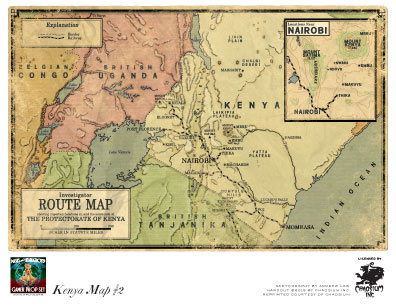 This is a reprint of Chaosium's handout, provided by permission. Cartography by Andrew Law. Keepers may wish to withhold this handout and use the large-format Kenya map instead.
This is a reprint of Chaosium's handout, provided by permission. Cartography by Andrew Law. Keepers may wish to withhold this handout and use the large-format Kenya map instead.
 We figured Madame Lin probably had very nice personal stationery, and designed some featuring a vintage image of a swallow in flight—her personal symbol—carrying cherry blossoms. The handwriting of the letter may or may not be that of Madame Lin herself: perhaps she dictates her letters to a secretary who does the writing for her. The letter is signed at the bottom with a red chop, indicating it is genuinely from Lin Yenyu.
We figured Madame Lin probably had very nice personal stationery, and designed some featuring a vintage image of a swallow in flight—her personal symbol—carrying cherry blossoms. The handwriting of the letter may or may not be that of Madame Lin herself: perhaps she dictates her letters to a secretary who does the writing for her. The letter is signed at the bottom with a red chop, indicating it is genuinely from Lin Yenyu.
 This handout is a transcript of the audio prop to be found on the thumb drive inside the Ediphone cylinder. Because this is meant to be direct testimony from a living person, we recommend that Keepers allow their players to hear the recording one time only. They may then choose to withhold this transcript, thus compelling their players to remember, or not, what Sgt. Bumption said. Merciful Keepers may choose to let their players have this transcript. Andrew Leman plays Sgt. Bumption.
This handout is a transcript of the audio prop to be found on the thumb drive inside the Ediphone cylinder. Because this is meant to be direct testimony from a living person, we recommend that Keepers allow their players to hear the recording one time only. They may then choose to withhold this transcript, thus compelling their players to remember, or not, what Sgt. Bumption said. Merciful Keepers may choose to let their players have this transcript. Andrew Leman plays Sgt. Bumption.
 This is a reprint of Chaosium's handout, provided by permission. Cartography by Andrew Law.
This is a reprint of Chaosium's handout, provided by permission. Cartography by Andrew Law.
 Chaosium's supplement says this item is an annotation in a Hindi version of The Black Tome from 1517. We thought it would be fun to provide a page actually torn from the book, with an English annotation, presumably by Taan Kaur, written in the margin.
Chaosium's supplement says this item is an annotation in a Hindi version of The Black Tome from 1517. We thought it would be fun to provide a page actually torn from the book, with an English annotation, presumably by Taan Kaur, written in the margin.
 This is a reprint of Chaosium's handout, provided by permission. Cartography by Andrew Law.
This is a reprint of Chaosium's handout, provided by permission. Cartography by Andrew Law.
 This handout is a transcript of the audio prop to be found on the thumb drive inside the Ediphone cylinder. Because this is meant to be direct testimony from a living person, we recommend that Keepers allow their players to hear the recording one time only. They may then choose to withhold this transcript, thus compelling their players to remember, or not, what Okomu says Bundari said. Merciful Keepers may choose to let their players have this transcript. Phillip C. Curry plays Okomu. We'll never tell who plays Bundari.
This handout is a transcript of the audio prop to be found on the thumb drive inside the Ediphone cylinder. Because this is meant to be direct testimony from a living person, we recommend that Keepers allow their players to hear the recording one time only. They may then choose to withhold this transcript, thus compelling their players to remember, or not, what Okomu says Bundari said. Merciful Keepers may choose to let their players have this transcript. Phillip C. Curry plays Okomu. We'll never tell who plays Bundari.
 This is a reprint of Chaosium's handout, provided by permission. Cartography by Andrew Law.
This is a reprint of Chaosium's handout, provided by permission. Cartography by Andrew Law.
 This is a reprint of Chaosium's handout, provided by permission. Cartography by Andrew Law.
This is a reprint of Chaosium's handout, provided by permission. Cartography by Andrew Law.
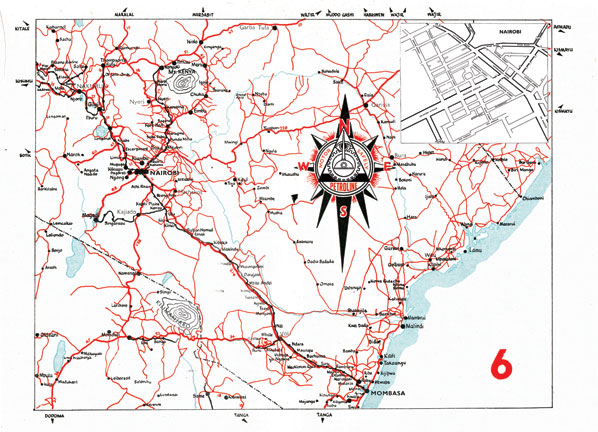 This large-format map is based on a real vintage driving map of Kenya published by a British petroleum company in the 1950s. We changed the name and logo of the company. Since this is a real vintage map without any Keeper information, you can give it to your players any time after they decide to go to Kenya. The Keeper maps of Kenya and Nairobi in the Chaosium supplement identify various locations of interest.
This large-format map is based on a real vintage driving map of Kenya published by a British petroleum company in the 1950s. We changed the name and logo of the company. Since this is a real vintage map without any Keeper information, you can give it to your players any time after they decide to go to Kenya. The Keeper maps of Kenya and Nairobi in the Chaosium supplement identify various locations of interest.
This map measures 18 x 13 inches.
 Chaosium's supplement prominently features The Nairobi Star, a fictional newspaper, but does not provide any actual clippings from it. We thought it would be fun to include some as bonus items. Our design is based on The East African Standard, a real newspaper published in Nairobi at the time. The news items and classified ads on the reverse of all Nairobi Star clippings are real ones lifted from the Standard. Our thanks again to HPLHS Member David G. Cercone II for doing research at the Library of Congress.
Chaosium's supplement prominently features The Nairobi Star, a fictional newspaper, but does not provide any actual clippings from it. We thought it would be fun to include some as bonus items. Our design is based on The East African Standard, a real newspaper published in Nairobi at the time. The news items and classified ads on the reverse of all Nairobi Star clippings are real ones lifted from the Standard. Our thanks again to HPLHS Member David G. Cercone II for doing research at the Library of Congress.
PLEASE NOTE: Your clipping may or may not be exactly the same size/shape as shown here. All the various newspaper clippings for this collection were designed and printed up in a giant full-size 12-page broadsheet newspaper. In order to get twice as many front pages, half of the newspaper is designed upside down. Our hard-working clipping shoggoths then meticulously disassemble these insanely complicated newspapers into the numerous different items, and there is always some variation in how specific individual clippings appear.
 This bonus clipping drops the names of a couple of NPCs that may be of interest to the Investigators.
This bonus clipping drops the names of a couple of NPCs that may be of interest to the Investigators.
 This half-page clipping from The Nairobi Star gives an opportunity for a photo of the site where the Carlyle Expedition remains were found. The photo itself is a composite of several locations, and shows Mt. Satima rising into the clouds in the distance.
This half-page clipping from The Nairobi Star gives an opportunity for a photo of the site where the Carlyle Expedition remains were found. The photo itself is a composite of several locations, and shows Mt. Satima rising into the clouds in the distance.
 This final clipping from The Nairobi Star gives some more detail on the Nandi tribesmen who took the fall for the "massacre". All of the ads on the reverse side are real except the one for Ahja Singh.
This final clipping from The Nairobi Star gives some more detail on the Nandi tribesmen who took the fall for the "massacre". All of the ads on the reverse side are real except the one for Ahja Singh.
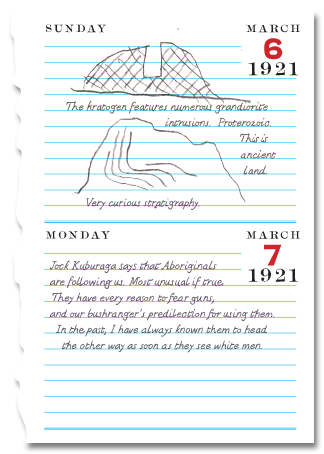 Several of the entries in this diary are from contiguous days, so we decided to lay out the various pages and add a few extra entries to fill the gaps. The pages are torn out of the diary and then paperclipped together. MacWhirr notes that the land of Western Australia is among the very oldest on the surface of the earth, and features the earliest evidence of life on the planet in the 3.5 billion-year-old rocks of the Pilbara.
Several of the entries in this diary are from contiguous days, so we decided to lay out the various pages and add a few extra entries to fill the gaps. The pages are torn out of the diary and then paperclipped together. MacWhirr notes that the land of Western Australia is among the very oldest on the surface of the earth, and features the earliest evidence of life on the planet in the 3.5 billion-year-old rocks of the Pilbara.
If your Investigators never met with Anthony Cowles, Keepers may wish to give them the photo of the Pnakotus ruins from the America folder along with this diary.
 This is a reprint of Chaosium's handout, provided by permission. Cartography by Andrew Law.
This is a reprint of Chaosium's handout, provided by permission. Cartography by Andrew Law.
 This is a reprint of Chaosium's handout, provided by permission. Cartography by Andrew Law. The Keeper's version printed in Chaosium's supplement has more specific information on it.
This is a reprint of Chaosium's handout, provided by permission. Cartography by Andrew Law. The Keeper's version printed in Chaosium's supplement has more specific information on it.
 This handout is a transcript of the audio prop to be found on the thumb drive inside the Ediphone cylinder. Because this is meant to be direct testimony from a living person, we recommend that Keepers allow their players to hear the recording one time only. They may then choose to withhold this transcript, thus compelling their players to remember, or not, what Jeremy Grogan said. Merciful Keepers may choose to let their players have this transcript. Sean Branney plays Jeremy Grogan.
This handout is a transcript of the audio prop to be found on the thumb drive inside the Ediphone cylinder. Because this is meant to be direct testimony from a living person, we recommend that Keepers allow their players to hear the recording one time only. They may then choose to withhold this transcript, thus compelling their players to remember, or not, what Jeremy Grogan said. Merciful Keepers may choose to let their players have this transcript. Sean Branney plays Jeremy Grogan.
 This is a reprint of Chaosium's handout, provided by permission. Cartography by Andrew Law.
This is a reprint of Chaosium's handout, provided by permission. Cartography by Andrew Law.
 This is a reprint of Chaosium's handout, provided by permission. Cartography by Andrew Law.
This is a reprint of Chaosium's handout, provided by permission. Cartography by Andrew Law.
 Chaosium's supplement describes the memo as "mimeographed". Mimeography is a printing process that was popularized in the late 1800s that uses stencils to force ink from a rotating drum onto paper. The stencils were usually prepared on a typewriter with the ribbon removed. People sometimes used inventive combinations of typewritten letters, numbers, and punctuation marks to create little illustrations, kind of like the original emoticons. Mimeograph machines were very commonly used in offices, churches, schools and other places that needed cheap printing, until they were replaced by photocopy machines in the late 1970s. Spirit duplicators, first invented in 1923, were a similar technology, except that the ink was incorporated into the stencil itself, and was released by a solvent (the "spirit"). Spirit duplicators (also called "ditto machines") produced a distinctive purple color and a smell that schoolchildren from the 1960s and '70s remember fondly, but the stencils wore out faster than real mimeograph machines did. Huston could have had either a mimeograph machine or a spirit duplicator down in Pnakotus.
Chaosium's supplement describes the memo as "mimeographed". Mimeography is a printing process that was popularized in the late 1800s that uses stencils to force ink from a rotating drum onto paper. The stencils were usually prepared on a typewriter with the ribbon removed. People sometimes used inventive combinations of typewritten letters, numbers, and punctuation marks to create little illustrations, kind of like the original emoticons. Mimeograph machines were very commonly used in offices, churches, schools and other places that needed cheap printing, until they were replaced by photocopy machines in the late 1970s. Spirit duplicators, first invented in 1923, were a similar technology, except that the ink was incorporated into the stencil itself, and was released by a solvent (the "spirit"). Spirit duplicators (also called "ditto machines") produced a distinctive purple color and a smell that schoolchildren from the 1960s and '70s remember fondly, but the stencils wore out faster than real mimeograph machines did. Huston could have had either a mimeograph machine or a spirit duplicator down in Pnakotus.
 This is a reprint of Chaosium's handout, provided by permission. Cartography by Andrew Law.
This is a reprint of Chaosium's handout, provided by permission. Cartography by Andrew Law.
 By this point your Investigators might well instantly recognize Gavigan's fancy stationery and handwriting.
By this point your Investigators might well instantly recognize Gavigan's fancy stationery and handwriting.
 Chaosium's supplement describes Huston's manuscript of Gods of Reality as being 600 pages long, but only provides one page worth. We thought it would be fun to expand on that, although we couldn't go all the way to 600. Our version is four blue-pencilled A4 pages, consisting of all of chapter 11. It does not bear Huston's signature, but sharp-eyed Investigators may notice that it is typed on the same distinctive typewriter that produced the mimeographed memo, which is at least initialed by Huston, thus giving a clue to its authorship.
Chaosium's supplement describes Huston's manuscript of Gods of Reality as being 600 pages long, but only provides one page worth. We thought it would be fun to expand on that, although we couldn't go all the way to 600. Our version is four blue-pencilled A4 pages, consisting of all of chapter 11. It does not bear Huston's signature, but sharp-eyed Investigators may notice that it is typed on the same distinctive typewriter that produced the mimeographed memo, which is at least initialed by Huston, thus giving a clue to its authorship.
 While searching for resources for this prop collection, we discovered a wonderful vintage brochure about Australia that was published in the 1920s by a bank in Sydney. The brochure included this wonderful map showing the average ocean travel times for places all over the world, and we thought it would make for a great bonus item. This is a replica of a real map with no Keeper information on it, so you can give it to your players at any time that seems appropriate.
While searching for resources for this prop collection, we discovered a wonderful vintage brochure about Australia that was published in the 1920s by a bank in Sydney. The brochure included this wonderful map showing the average ocean travel times for places all over the world, and we thought it would make for a great bonus item. This is a replica of a real map with no Keeper information on it, so you can give it to your players at any time that seems appropriate.
This map measures 14 x 6.5 inches.
 This large-format map is an edited replica of a real map from 1923. We have added the Canning Stock Route and a couple of specific game locations to it. It does not contain any Keeper-only information, however, so you can give it to your players any time once they've decided to go to Western Australia.
This large-format map is an edited replica of a real map from 1923. We have added the Canning Stock Route and a couple of specific game locations to it. It does not contain any Keeper-only information, however, so you can give it to your players any time once they've decided to go to Western Australia.
This map measures 14 x 18 inches.
 This is a clipping from The Shanghai Courier, a fictional newspaper. Our design is inspired by The Shanghai Evening Post and Mercury, a real newspaper published in the early 1940s. Ads and news items on the backs of clippings are lifted from The Shanghai Mercury from the 1920s. Our thanks again to HPLHS Member David G. Cercone II for doing research at the Library of Congress.
This is a clipping from The Shanghai Courier, a fictional newspaper. Our design is inspired by The Shanghai Evening Post and Mercury, a real newspaper published in the early 1940s. Ads and news items on the backs of clippings are lifted from The Shanghai Mercury from the 1920s. Our thanks again to HPLHS Member David G. Cercone II for doing research at the Library of Congress.
PLEASE NOTE: Your clipping may or may not be exactly the same size/shape as shown here. All the various newspaper clippings for this collection were designed and printed up in a giant full-size 12-page broadsheet newspaper. In order to get twice as many front pages, half of the newspaper is designed upside down. Our hard-working clipping shoggoths then meticulously disassemble these insanely complicated newspapers into the numerous different items, and there is always some variation in how specific individual clippings appear.
 This is another clipping from The Shanghai Courier. The ad on the back is for Union Brewery beer, produced in Shanghai.
This is another clipping from The Shanghai Courier. The ad on the back is for Union Brewery beer, produced in Shanghai.
 This half-page clipping from The Shanghai Courier gives an opportunity for the players to get some context, and see real news items, ads, and photos from the day. The picture on the reverse shows the Bund, although it is slightly anachronistic. The photo was taken in about 1928, a few years after the events of the game. But it was such a nice picture otherwise we decided to include it.
This half-page clipping from The Shanghai Courier gives an opportunity for the players to get some context, and see real news items, ads, and photos from the day. The picture on the reverse shows the Bund, although it is slightly anachronistic. The photo was taken in about 1928, a few years after the events of the game. But it was such a nice picture otherwise we decided to include it.
 This clipping from The Shanghai Courier puts the game ad next to a real one for Montserrat Pulpy Lemon Squash.
This clipping from The Shanghai Courier puts the game ad next to a real one for Montserrat Pulpy Lemon Squash.
 This is a reprint of Chaosium's handout, provided by permission. Cartography by Andrew Law.
This is a reprint of Chaosium's handout, provided by permission. Cartography by Andrew Law.
 This is a reprint of Chaosium's handout, provided by permission. Cartography by Andrew Law.
This is a reprint of Chaosium's handout, provided by permission. Cartography by Andrew Law.
 This is a reprint of Chaosium's handout, provided by permission. Cartography by Andrew Law.
This is a reprint of Chaosium's handout, provided by permission. Cartography by Andrew Law.
 Chaosium's supplement describes this item as a scroll, and we thought it would be fun to provide a real Chinese scroll. But it's too big to fit in this folder, so it is packed in the box separately, and this handout contains the English translation for Investigators who succeed in reading the real scroll. Our special thanks to Ellen Fung and David Mersault for translation assistance.
Chaosium's supplement describes this item as a scroll, and we thought it would be fun to provide a real Chinese scroll. But it's too big to fit in this folder, so it is packed in the box separately, and this handout contains the English translation for Investigators who succeed in reading the real scroll. Our special thanks to Ellen Fung and David Mersault for translation assistance.
 This item is also described as a scroll in Chaosium's supplement, but we blew our scroll budget on the first one, so we reimagined this as being written on some zhezhi paper. Zhezhi is the Chinese art of paper folding, similar to Japanese origami, but different in that it usually depicts inanimate objects rather than animals or flowers. The Chinese invented paper and have been folding it into decorative and ceremonial works for a very long time. We like to imagine that Madame Lin has a servant who spends time folding lovely hats, boats, and golden ingots, and has lots of this paper on hand.
This item is also described as a scroll in Chaosium's supplement, but we blew our scroll budget on the first one, so we reimagined this as being written on some zhezhi paper. Zhezhi is the Chinese art of paper folding, similar to Japanese origami, but different in that it usually depicts inanimate objects rather than animals or flowers. The Chinese invented paper and have been folding it into decorative and ceremonial works for a very long time. We like to imagine that Madame Lin has a servant who spends time folding lovely hats, boats, and golden ingots, and has lots of this paper on hand.
 This is a reprint of Chaosium's handout, provided by permission. Cartography by Andrew Law.
This is a reprint of Chaosium's handout, provided by permission. Cartography by Andrew Law.
 This brief note is written on thin rice paper so that it can be eaten. We don't know why Min didn't eat this particular note. Jack Brady's man-of-action penmanship is by Sean Branney.
This brief note is written on thin rice paper so that it can be eaten. We don't know why Min didn't eat this particular note. Jack Brady's man-of-action penmanship is by Sean Branney.
 This handout is a transcript of the audio prop to be found on the thumb drive inside the Ediphone cylinder. Because this is meant to be direct testimony from a living person, we recommend that Keepers allow their players to hear the recording one time only. They may then choose to withhold this transcript, thus compelling their players to remember, or not, what Jack Brady said. Merciful Keepers may choose to let their players have this transcript. Shawn Michael Savage plays Jack Brady.
This handout is a transcript of the audio prop to be found on the thumb drive inside the Ediphone cylinder. Because this is meant to be direct testimony from a living person, we recommend that Keepers allow their players to hear the recording one time only. They may then choose to withhold this transcript, thus compelling their players to remember, or not, what Jack Brady said. Merciful Keepers may choose to let their players have this transcript. Shawn Michael Savage plays Jack Brady.
 This page of notes is written my Mu Hsien and torn from his notebook.
This page of notes is written my Mu Hsien and torn from his notebook.
 This is a reprint of Chaosium's handout, provided by permission. Cartography by Andrew Law.
This is a reprint of Chaosium's handout, provided by permission. Cartography by Andrew Law.
 The great epistolarian Edward Gavigan returns with another revealing missive.
The great epistolarian Edward Gavigan returns with another revealing missive.
 This item is based not on a real vintage Chinese telegram, but on a real vintage movie prop version of a Chinese telegram. When Andrew Leman first moved to Los Angeles he got a job in one of the oldest prop houses in town, and they had file cabinets full of old movie prop documents. When the company went out of business at last, Andrew saved some of those old movie props from the dumpster, including this 1940s-era Chinese telegram. The Chinese postage stamp from the 1920s was added as a little bonus.
This item is based not on a real vintage Chinese telegram, but on a real vintage movie prop version of a Chinese telegram. When Andrew Leman first moved to Los Angeles he got a job in one of the oldest prop houses in town, and they had file cabinets full of old movie prop documents. When the company went out of business at last, Andrew saved some of those old movie props from the dumpster, including this 1940s-era Chinese telegram. The Chinese postage stamp from the 1920s was added as a little bonus.
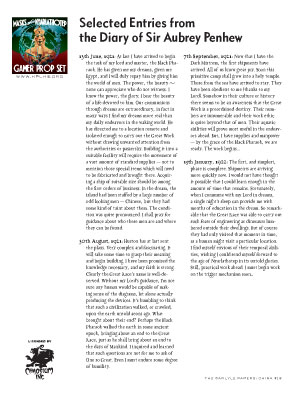 The diaries of Sir Aubrey Penhew are described in Chaosium's supplement as occupying many volumes spread out over years of time, and there was just no practical way we could render them in prop form, so we are offering this handout of crucial excerpts instead. However, we did beef them up considerably and add more detail.
The diaries of Sir Aubrey Penhew are described in Chaosium's supplement as occupying many volumes spread out over years of time, and there was just no practical way we could render them in prop form, so we are offering this handout of crucial excerpts instead. However, we did beef them up considerably and add more detail.
 This large-format map is a detail of a fantastic map of Shanghai from 1919 we found in the Library of Congress. We added Lantern Street and put a number of unlabeled Xs on the map at places of interest in the game. We think this is Jack Brady's personal map of the city.
This large-format map is a detail of a fantastic map of Shanghai from 1919 we found in the Library of Congress. We added Lantern Street and put a number of unlabeled Xs on the map at places of interest in the game. We think this is Jack Brady's personal map of the city.
This map measures 18 x 18 inches.
 This large-format bonus map is a nautical chart of the East China Sea that shows the location of Gray Dragon Island. The Investigators might acquire it from Jack Brady, or from Chu Min.
This large-format bonus map is a nautical chart of the East China Sea that shows the location of Gray Dragon Island. The Investigators might acquire it from Jack Brady, or from Chu Min.
This chart is 11 x 17 inches.
